Abstract
Interactions between precipitation, vegetation, and erosion are crucial and not fully solved issues in the area of earth surface processes. The Qingshui River Basin (QRB), as the main sediment source tributary of the upper reaches of the Yellow River, is characterized by spatial heterogeneity of rainfall, vegetation, and soil erosion. In this study, we investigated the spatiotemporal variations of sediment yields within the QRB and further identified the coupling effects of precipitation and vegetation on soil erosion. We collected annual (1955 to 2016) and daily (2006 to 2016) hydrological and sediment series from six hydrological stations, which subdivided the whole basin into six different sub-basins with heterogeneity in climate and landscape. Variations in parameter a of the sediment rating curves among the six sub-basins continuously declined, showing the continuously increasing effect of vegetation coverage on reducing soil erosion. The unique combination of relationships between precipitation characteristics and vegetation patterns in six sub-basins and these coupling effects resulted in different precipitation–vegetation–erosion patterns in six sub-basins. Sediment yield followed bell-shaped relationships with vegetation and precipitation, with a clear critical threshold at normalized difference vegetation index (NDVI) = 0.36/precipitation = 100 mm at a monthly scale. Based on these thresholds, the non-linear relationships between precipitation, vegetation, and erosion were also explained. We also found that reducing the time lags in which vegetation follows precipitation may be effective in suppressing sediment yield. These findings could provide a quantitative approach to estimating the potential changes in sediment yield associated with proposed ecological rehabilitation schemes in this region.
1. Introduction
The river sediment load is an essential indicator that realistically represents the variations in soil erosion intensity and plays a significant role in sediment fluxes and the biogeochemical cycle [1]. The erosion, transport, and redeposition of sediment can modify and reshape the Earth’s surface, having a significant impact on the structures, processes, and functions of socio-ecological systems [2,3].
Over the last few decades, there have been significant shifts in the sediment load of rivers as a result of the coupling effects of global climatic change and anthropogenic activities [4,5]. Walling and Fang [1] investigated the trends of 146 main rivers throughout the world and revealed that around half of them demonstrated statistically significant upturns or downturns, with the majority exhibiting decreasing trends. According to the results of Li et al. [5], of the world’s large rivers that have been surveyed, most notably declining trends were detected in water and sediment fluxes in Asia’s large rivers, which could be attributed to the rapid human intervention of river sediment balance. The baseline load and magnitude of the variations exert a key effect on the benefits and risks of the changes in river sediment load. As a consequence, it is essential to quantitatively assess the shifts in river sediment load over time and comprehend the underlying drivers and mechanisms [3].
The Yellow River (YR) is well recognized for its exceptionally high sediment load, contributing to 6% of the ocean sediment load and earning it the name “Yellow” [6]. It has also been subjected to numerous disasters due to a large amount of sediment and catastrophic floods [7,8]. Due to readily erodible soils, sparse vegetation, steep slopes, inappropriate exploitation, and recurrent summer high-intensity rainstorms, the Loess Plateau (LP), through which the YR flows, has one of the greatest soil erosion rates in the world [9,10,11]. Chronic severe soil erosion leads to the destruction of agricultural areas onsite and the siltation of reservoirs and river beds offsite, as well as flooding in the YR [12,13,14,15].
Known for its serious sediment issues, the YR has been the subject of many studies on ecological restoration practices and sediment control for decades [16,17]. Since the 1950s, a wealth of management strategies and ecological restoration techniques have been employed in the YR to progressively alleviate soil erosion and mitigate the sediment load. In particular, the total annual sediment load of the YR has decreased sharply from 16 Gt/a in 1919–1959 to approximately 2.44 Gt/a in 2000–2018 [18,19]. Remarkable ecological restoration practices, such as terraces, check dams, afforestation, and grass planting have been employed to trap the sediment of gullies and slopes in the YR, effectively influencing the sediment yield and transport process [20]. Numerous studies have sought to quantify these changes, and have confirmed that human impacts have a larger influence on sediment yield than climate change in these areas [21,22]. Wang et al. [3] identified that the primary reasons for the fall in sediment yield since the 1970s could be attributed to terracing, check dams, reservoirs, etc. With the gradual siltation of check dams and reservoirs, vegetation restoration, which was extensively carried out in the 1990s, would potentially play a critical role in curtailing soil erosion for the YR. Since then, numerous studies have identified the restoration of perennial vegetation, efficiently stabilized soils, and alleviated erosion [23,24,25]. Murray et al. [26] reported that vegetation rehabilitation has considerable impacts on the runoff–sediment processes, revealing its major contribution to sediment load decrease in the YR [16]. Precipitation is also an important factor that strongly affects the sediment transport process. It plays important role in soil detachment, whereas surface runoff is the basic driving factor for the transport of sediment, an essential prerequisite for sediment-laden flow conveyance mechanisms when a specific hydrological event happens [27]. The inter-relations among rainfall, vegetation, and erosion are important and unsolved issues in the research on the processes occurring on the Earth’s surface [28]. The relationships at the micro-scale (chiefly based on the results of runoff plots) between precipitation, vegetation cover, runoff, and sediment yield are relatively well established. However, there is no commonly accepted conclusion from the perspective of basins, since the proposed empirical formulas established from runoff plots failed when it was extended to basins [25]. Therefore, exploring the relationships between precipitation, vegetation, and erosion can help us better understand the spatial distribution and dynamics of sediments through basins. Moreover, the introduction and application of numerous vegetation indices provide opportunities to monitor and analyze the vegetation of large-scale regions using remote sensing datasets [29]. Huang et al. [30] used partial least squares-structural equation modeling (PLS-SEM) to decouple the effects of precipitation and vegetation in sediment yield in the Upper Du Basin of subtropical China. Xu [28] determined non-linear relationships between vegetation cover, rainfall erosivity, and annual rainfall, and identified some thresholds based on data from the LP of China.
More specifically, the study of the responses of vegetation growth processes to climate factors has taken on a new level of importance in recent years due to the subject of global climate change [31,32]. In particular, many studies have been performed on the vegetation dynamics and coupled relationships between vegetation and climatic factors based on multiple vegetation indices. Vegetation growth trends are only considered to respond to climatic factors when climate change exceeds the tolerance of the vegetation. Consequently, climate factors affect vegetation both dynamically and asymmetrically with time lags or time-accumulation effects [33]. A number of recent studies have linked NDVI to the time-lagged effects of climatic factors. For example, Ding et al. [34] determined the spatial and temporal patterns of climate impacts on global vegetation growth based on several time-lag scenarios. However, previous studies have generally focused on the occurrence of time lags and their spatial distributions, while further study into the influence of time lags on sediment yield is lacking, despite its practical applications for vegetation restoration and sediment trapping, as well as other strategies that benefit local ecosystems.
In addition to being the main sediment yield region of the LP, the upper YR is also the major runoff-producing region, contributing more than half of the total annual discharge. In recent years, however, this area has recently fallen into relative neglect due to the occurrence of fewer anthropogenic activities compared to the midstream and downstream. Simultaneously, the runoff and sediment load of the upper YR have also both been significantly reduced as a result of recent land-use changes and the development of water and soil conservation programs [35]. Shifts in the upper YR will ultimately have an impact on the lower reaches. In order to effectively manage the river basin, it is important to identify the runoff and sediment load trends in the upper reaches based on the current conditions. The Qingshui River Basin (QRB) is the largest tributary of the Ningxia section of the Yellow River, as well as the river with the most serious soil erosion in Ningxia, with the annual sediment load emptying into the YR and accounting for approximately 49% of the total sediment load of Ningxia [36]. The objectives of this paper are listed below: (1) to identify the evolution of the runoff–sediment relationship in the QRB and reflect its recent variations with the widely recognized runoff–sediment regression equation; (2) to establish the coupling effects among precipitation, vegetation, and sediments and determine their thresholds; and (3) to quantify the lag time of vegetation’s response to precipitation in the QRB and clarify the influence of vegetation time lag on sediment yield. An improved understanding of the evolution of the relationship between runoff and sediment and the precipitation–vegetation coupling effects would provide a theoretical basis and quantitative approach for soil and water conservation policies and vegetation restoration.
2. Materials and Methods
2.1. Study Area
The Qingshui River is a first-order tributary of the upper YR and empties into the YR in Quanyanshan, Zhongning County of Ningxia, and the QRB is the area with the most severe erosion at the Ningxia province section of the YR. The QRB spans 35°53′–37°28′ N and 105°12′–106°38′ E and encompasses an area of about 14,480 km2 (Figure 1). The total length of the main stream in the QRB is almost 320 km and the average river gradient is approximately 0.149%.
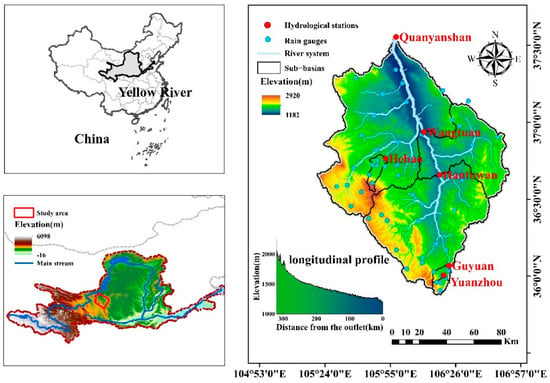
Figure 1.
The geographical location of the studied basin, hydrological stations, and rain gauges.
Figure 1 exhibits the longitudinal profile of the main stream. The topography within the QRB slopes from the southern to the northern region in an undulating pattern, with loess hilly regions as the principal geomorphological features. It is located in a semi-arid climate zone with a mean temperature of 6.2 °C. The mean annual precipitation is approximately 349 mm, varying from 600 mm upstream to 200 mm downstream. The precipitation is unevenly distributed throughout the year, mainly occurring between July and September with a coefficient of variation (Cv) ranging from 0.24 to 0.35. The long-term variation range of precipitation increases with the decreasing precipitation amount from the upper to lower reaches. Concentrated runoff in the rainy season generally results in serious soil erosion and large sediment yields. The arid and high-concentrated precipitation patterns and unique geological and geomorphological features have led to large amounts of sediment yields in the QRB. In particular, the extreme erosion modulus is 13,200 t/km2.
Six major hydrological stations are primarily involved in the QRB, namely Yuanzhou, Guyuan, Hebao, Hanfuwan, Wangtuan, and Quanyanshan, where Quanyanshan is the controlled hydrologic station of the QRB. The whole QRB is partitioned into six sub-basins by the six hydrological stations, which are situated at the outlet of each sub-basin, and these six sub-basins showed spatially nested relationships (Figure 1). The designation of these sub-basins is abbreviated as YZ, GY, HB, HFW, WT, and QYS, according to the names of the hydrological stations, and the control areas for the six sub-basins are listed in Table 1. There were significant differences in runoff and sediment discharge among different sub-basins. The average annual erosion modulus of GY is 3024 t/km2, with moderate soil erosion despite the high rainfall amounts. HFW covers about 1/3 of the whole basin while accounting for approximately 60% of the annual discharge. The section from HFW to WT is the most seriously eroded area, with a mean annual erosion modulus of 7710 t/km2. In contrast, soil erosion is relatively light in the section from WT to QYS due to the low rainfall.

Table 1.
Hydrological characteristics of the QRB and data series.
2.2. Data Collection and Processing
2.2.1. Discharge and Sediments
The Yellow River Conservancy Commission (YRCC) of the Ministry of Water Resources of China has established a range of hydrological stations to record the discharge and sediment processes, and runoff and sediment discharge at the aforementioned six hydrological stations were collected from the Yellow River Hydrological Yearbook compiled by YRCC, China. The entire procedure, including sampling and experimental measurements, was in full accordance with international standards and procedures, and all results were rigorously validated prior to publication. Table 1 represents the salient features of the hydrological stations and the collection of discharge and sediment. Note that the data records of the six hydrological stations have different time lengths and time intervals. Three stations, GY, HFW, and QYS, located upstream, middle, and downstream of the basin, respectively, have long-term data records, and these series were adopted to investigate the temporal variations of runoff and sediment discharge series (Table 2). Meanwhile, four stations, YZ, HB, HFW, and QYS, have daily records from 2006 to 2016, and records from these four stations were used to analyze the evolution of the runoff–sediment relationship.

Table 2.
Results of trends in annual discharge and annual sediment yield from 1960 to 2016 based on the MK test.
2.2.2. Precipitation
Daily precipitation records from 2006 to 2016 at 57 rain gauges were provided by the Hydrological Yearbooks of the People’s Republic of China, and monthly and annual precipitation series were accumulated from daily data.
The spatial distribution of precipitation within the QRB was obtained by using the widely-used ordinary kriging interpolation method [37], which was reported to exhibit optimal precision and results for the interpolation of precipitation in the YR [38]. Figure 2 displays the spatial pattern of the average annual precipitation from 2006 to 2016. The annual mean precipitation presented as decreasing from upstream to downstream, and the mean annual precipitations of YZ, GY, HB, HFW, WT, and QYS are about 468.8 mm, 459 mm, 330 mm, 371.3 mm, 302.5 mm, and 267 mm, respectively.
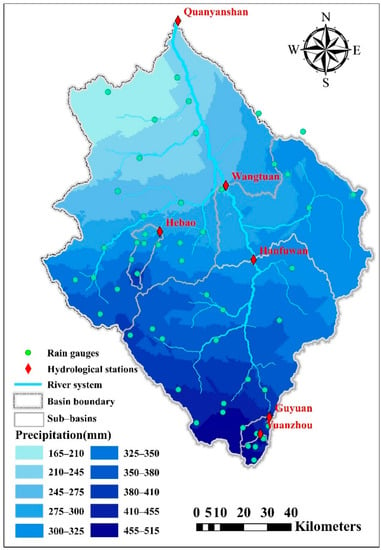
Figure 2.
Spatial distribution of the average annual precipitation in the QRB from 2006 to 2016.
2.2.3. NDVI
The monthly normalized difference vegetation index (NDVI), a dimensionless vegetation cover reflectance indicator, was used in this study to analyze the spatial distribution and fluctuations of the vegetation coverage within the QRB. The datasets have a temporal resolution of 16 days and a spatial resolution of 250 m, spanning from 2000 to the present, and were downloaded from NASA (https://ladsweb.modaps.-eosdis.nasa.gov/ (accessed on 25 May 2019)). The MRT (MODIS Reprojection Tool) was used to reproject the datasets in order to extract the NDVI of the QRB via mask extraction. The Maximum Value Composites (MVC) were used to calculate the annual and monthly NDVI. This method can effectively eliminate the partial influence and disturbance of clouds, the atmosphere, and solar altitude angle [39]. The annual NDVI (2006–2016) reveals a declining trend in vegetation from the upper to lower reaches, agreeing with the spatial pattern of the average annual precipitation of the QRB (Figure 3). Figure 4 plots the density curves for the six sub-basins from 2006 to 2016. The density curve wave crests are generally concentrated in areas with NDVI < 0.2, while the NDVI values of YZ and GY exhibit two wave crests, and another density curve wave crest is mainly concentrated in the area with NDVI values exceeding 0.5.
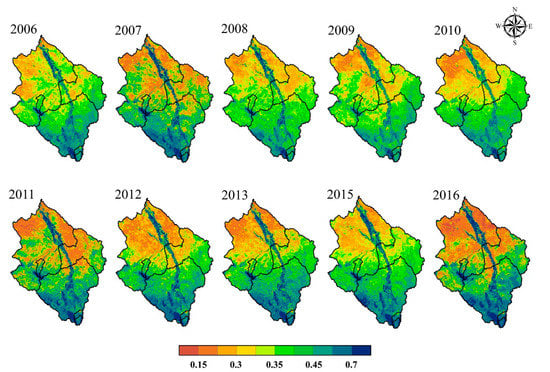
Figure 3.
Spatial distribution of the NDVI in the QRB from 2006 to 2016.
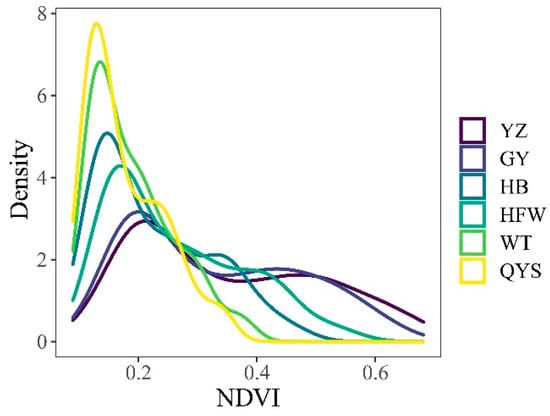
Figure 4.
Density curves of the NDVI in the six sub-basins of the QRB from 2006 to 2016.
2.2.4. Land Use
High-Resolution Landsat Thematic Mapper (TM) images were selected to create the land-use databases using ENVI5.3 (Exelis Visual Information Solutions, Boulder, Colorado, CO, USA). ENVI5.3 supports a wide range of sensors and data formats, with new and improved image processing algorithms and the integration of LiDAR processing, making it more suitable for integration with ArcGIS. Following geometric, radiometric, and atmospheric correction, a land-use map was generated through the combination of machine interpretation and visual interpretation. Moreover, the CART (classification and regression tree) was utilized to extract the land-use information of the QRB. The preliminary classification results were achieved by constructing the classification trees from the training samples, and then the preliminary classification images were modified by visual interpretation to improve the classification accuracy and acquire the final results. The random point method was used to detect the classification accuracy, and the number of the validation samples required to satisfy the confidence level of the classification result was determined according to the following equation:
where n is the validation sample; Zα/2 is the desired level of significance (95% confidence level was selected in this study, with a statistic of 1.96 for z); P is the precision of the proportion estimate (α value of 0.5 was selected for this study when its sample variability was at its maximum); and d denotes the sampling error allowed.
In this study, 1536 samples were chosen. The total accuracy of the classification results, as well as the Kappa coefficient, were derived by calculating the confusion matrix with the aid of satellite maps of Google Earth v7.3.4 high-resolution historical images. The final results show that the overall accuracy of the classification results exceeds 80% and the kappa coefficient exceeds 0.75, indicating that results are reliable.
The land use of the QRB is classified into six categories: grassland, forest, water bodies, bare land, urban area, and cropland (Figure 5). Grassland is the dominant land use type and the proportion of it in the QRB is 76%–84.3%. Cropland is mainly distributed along the main stream. Forest is primarily distributed in the upper reaches, while bare land is mostly concentrated in the lower reaches. From 2006 to 2016, land use in the QRB has been relatively stable and there have been no significant changes.
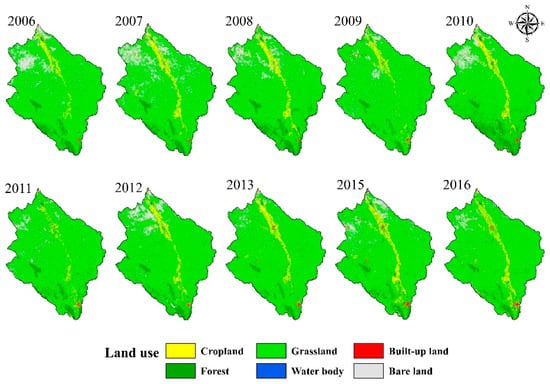
Figure 5.
Land use in the QRB from 2006 to 2016.
2.3. Sediment Rating Curves (SRCs)
Sediment rating curves (SRCs) can provide insights into the connection between runoff and sediment for a given region, and are thus employed to understand the trends in the sediment supplies and transportation across multiple timescales, as well as to predict sediment dynamics as a function of stream flow [40,41,42,43].
The widely used SRCs are generally expressed as power functions:
which can alternatively be denoted as a linearized function after logarithmic transformation:
where Qs is sediment load (t), Q is water discharge (m3), and a and b are the coefficient and exponent of the SRCs, respectively.
Numerous studies have been conducted to research the physical implications of parameters a and b, connecting them to basin features (e.g., basin area and riverbed morphology) [44,45]. Parameter a acts as an indicator of soil erodibility, where large values denote the abundance of sediment deposits on slopes, which could be carried away by runoff, and parameter b is an indicator presenting the erosivity and transfer capacities of streams, where large values denote the large sediment carrying capacity of the stream flow.
2.4. Trend Analysis
The commonly used nonparametric Mann–Kendall (MK) test [46,47] has been used to detect the trend of annual streamflow and sediment discharge. This method generally provides an efficient ability to discriminate the monotonic trends in hydrometeorological data series without requesting time series to follow a certain distribution or being susceptible to outliers.
The test statistic S is constructed based on a specific time series, Xt = {x1, x2, …, xn}, which can be expressed as follows:
where n is the length of the data series, while xi and xj denote values of data at time i and time j, respectively.
The test statistic Z is then derived as follows:
Under the null hypothesis of no trend, the test statistic Z has a standard normal distribution with zero and unit variance. A positive Z value represents an ascending trend in the time series and vice versa.
To estimate the true slope of the existing trend, the non-parametric test method introduced by Sen [48] was used. The interval of the rate of data change values (slope range) was derived, and the median size was then used to determine the trend of monotonous variation per unit of time, which is easy and convenient as a supplemental, unbiased estimator in the MK trend analysis. The slope of the trend is calculated as follows:
where β is the trend of the time series and xi and xj indicate values of time series at time i and time j, respectively. When β > 0, the time series exhibit an upward trend and vice versa.
2.5. Precipitation-Vegetation Coupling
Given the non-linear and complicated relationships between precipitation, vegetation, and erosion, two indices are firstly adopted, i.e., the index of NDVI is used to describe vegetation coverage, while specific sediment yield is considered as the indicator of the net outcomes of the erosion and deposition process for a basin, which is commonly calculated as the ratio of sediment yield to basin area in units of t/km2. Then, the method of local polynomial regression fitting is used to describe the influence of precipitation–vegetation coupling on erosion processes. Local polynomial regression fitting is a method to smooth two-dimensional scatterplots and to combine the simplicity of traditional linear regression with the flexibility of non-linear regression. This method does not require a predetermined function to fit a model to all the data. With this advantage, it is possible to fit the same data several different times to explore possible relationships in the data in a way that is not possible with ordinary regression fitting.
2.6. Correlation Analysis
The possible links between climatic factors and vegetation are explored using the Pearson correlation coefficient between the precipitation and NDVI, which can be determined as follows:
where n is the size of the samples, i is the time, Pi is the precipitation, and P and NDVI are the arithmetic mean of P and NDVI, respectively. R > 0 indicates the positive correlation between the precipitation and NDVI, and vice versa. The significance level of the correlation coefficient is determined by using a t-test.
3. Results
3.1. Trends of River Runoff and Sediment Discharge
As stated in Section 2.2.1, data records from GY, HFW, and QYS, the stations with long-term observations, were analyzed to derive the dynamic long-term trends in river runoff and sediment discharge (Figure 6). Note that the data of river runoff and sediment discharge at three stations were selected to start in different years due to data availability. Besides, substantial inter-annual fluctuations were also indicated in Figure 6. For instance, the annual runoff at QYS fluctuated widely from 1680 × 104 m3 (1960) to 39,260 × 104 m3 (1964), with an average of 11,473 × 104 m3 and a coefficient of variation (Cv) reaching 0.58. The annual sediment yield varied considerably from 8.43 × 104 t in 1960 to 12,000 × 104 t in 1958, with an average of 2585 × 104 t and a Cv of 1.02. Taking the average annual sediment yield of 2753 × 104 t during 1958–1969 as a benchmark, the sediment yield in the 1970s, 1980s, as well as 2000–2016 fell by 31% (1899 × 104 t), 34.9% (1790 × 104 t), and 31.1% (1898 × 104 t), respectively, while values increased in the 1990s (4454 × 104 t). Inter-annual variation coefficients of the annual discharge at GY, HFW, and QYS were determined as 0.75, 0.89, and 0.58, respectively, while those of the annual sediment yield were 1.43, 1.1, and 1.02, respectively. This suggests that the inter-annual variation of the annual sediment yield at QRB exceeds that of the annual discharge.
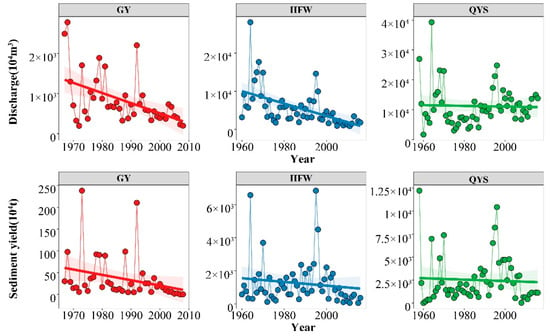
Figure 6.
Annual river runoff and sediment discharge of GY, HFW, and QYS during 1960–2016.
Table 2 presents the statistical analysis results based on the MK nonparametric test. Decreasing trends were observed for the annual river runoff and sediment discharge at GY, along with the annual discharge at HFW (0.01 significance level). No significant downward trends for the annual sediment yield were detected at HFW, and similarly, no significant upward trends for the annual river runoff and sediment discharge were identified at QYS. The results of Sen’s slope demonstrate that the rate of decrease in annual discharge (sediment yield) varies from −119.56 to −18.75 × 104 m3 (−6.86 to −0.66 × 104 t). Although an upward trend was noted for QYS, it did not satisfy the 95% significance test. Furthermore, both river runoff and sediment discharge experienced marked reductions at QYS after 1999, which was also generally true for the annual river runoff and sediment discharge in the QRB.
3.2. Relationships between River Runoff and Sediment and the Evolution
The SRCs were transformed from a power to linear form using a log transformation. The sediment rating parameters (loga and b), as well as the corresponding determination coefficient (R2), were determined using least-squares regression based on the annual observed runoff and sediment yield.
Figure 7 displays the SRCs fitted to the observed data for GY, HFW, and QYS during 1960–2016. The loga parameter varied from −10.4–−1.71, with an average value of −6.5, while parameter b spanned from 1.01 to 2.01, with a mean value of 1.54. This implies that the performance of the fitted SRCs varies across basins and underlying surfaces. The R2 coefficients for all curves exceeded 0.55 and all regressions were statistically significant (p < 0.001).

Figure 7.
SRCs at three hydrological stations with annual records during 1960–2016 (shown in Table 1). Qs is the annual sediment yield (104 t) and Q is the annual discharge (104 m3).
On the basis of the daily recorded river runoff and sediment discharge of YZ, HB, HFW, and QYS (Table 1), the SRC parameters (loga and b) were also derived. Figure 8 plots the SRC parameters at four hydrological stations during 2006–2016. Throughout the entire study period, the loga parameter reveals distinct time-dependent tendencies, while no significant trends were observed for coefficient b at all hydrological stations. The decline in loga for the four stations demonstrated the decrease in erodible sediment sources from the basin, implying the effective function of soil conservation measures on slopes, e.g., vegetation afforestation.
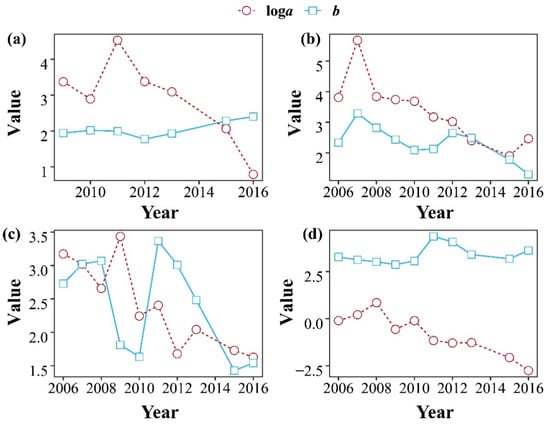
Figure 8.
Trends in the parameters a and b of SRCs for four hydrological stations: (a) YZ, (b) HB, (c) HFW, and (d) QYS.
3.3. Relationship between Precipitation, Vegetation, and Erosion
To reveal the influence of precipitation–vegetation coupling on erosion processes, scatterplots between precipitation, vegetation, and erosion were plotted separately. Figure 9 depicts the correlation between precipitation and NDVI based on the monthly NDVI and precipitation from six sub-basins during 2006–2016. The vegetation cover increased with monthly precipitation, which agrees with previous research [49,50]. Compared to high precipitation levels, the monthly maximum NDVI exhibited greater fluctuations at low precipitation levels. Higher NDVI values were clustered upstream of the QRB, owing to high precipitation. Lower NDVI values were generally observed downstream of the QRB due to less precipitation.
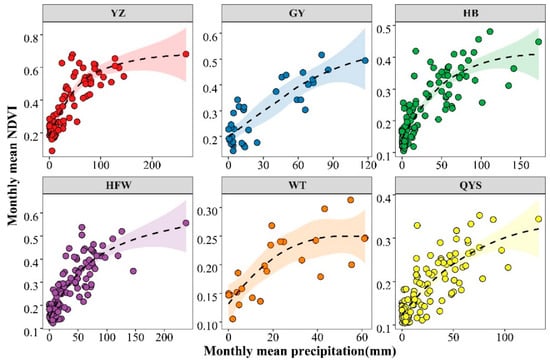
Figure 9.
Relationships between monthly mean precipitation and NDVI.
Figure 10 plots NDVI against specific sediment yield on a monthly scale. The monthly specific sediment yield follows a bell-shaped trend with NDVI, with a maximum specific sediment yield at the NDVI value of approximately 0.36. In contrast, for sub-basins with maximum NDVI values less than 0.36, the specific sediment yield increases exponentially with the NDVI.
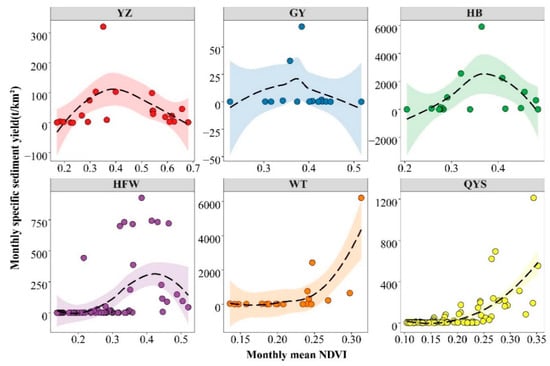
Figure 10.
Relationships between monthly specific sediment yield and the NDVI.
The nonlinear effect of vegetation in terms of sediment resistance to erosion follows that of the previous literature [51,52]. Vegetation is undeniably an important determinant of sediment reduction and could be considered as a useful indicator of both soil erosion and the transport of sediment in the QRB, despite the fact that the possible contribution of additional factors is not accounted for here. The relationship between monthly precipitation and specific sediment yield was nonlinear (Figure 11), with an explicit critical threshold of approximately 100 mm. As the monthly precipitation increases, the specific sediment yield also increases, reaching a maximum of around 100 mm. Following this, further increases in monthly precipitation were associated with a steady decline in the monthly specific sediment yield.
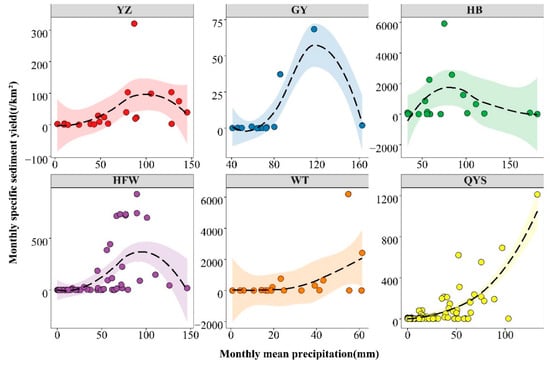
Figure 11.
Relationships between monthly specific sediment yield and monthly precipitation.
3.4. Time Lag Effect of Vegetation Response to Precipitation
Fluctuations in vegetation cover and climatic conditions are strongly associated with arid and semi-arid areas. The time lag between these structure and pattern alterations and vegetative responses is a critical driver of vegetation–climate interactions and varies tremendously according to the geospatial heterogeneity of the ecosystem. The response of vegetation dynamic to sediment yield is also accurately simulated and revealed after taking the effects of time lag into consideration. Vegetation growth manifests a significantly slower response to seasonal precipitation variations than does sediment yield. As a result, the effects of time lag must be accounted for to fully comprehend the interactions between precipitation, vegetation, and sediment yield. Previous research has determined that the time lag in vegetation’s response to seasonal precipitation at the monthly scale is typically no more than 3 months [53]. As a result, in the current study, we considered time lags between 0 and 3 months (lag = 0, 1, 2, and 3) and employed a correlation analysis to investigate the correlation between precipitation and vegetation at the monthly scale. Note that winter seasons were not taken into account owing to the sparse vegetation in winter. The results are listed in Table 3. The optimal time for the monthly NDVI response to monthly precipitation is the lag month with the greatest value of correlation coefficient (R). The results show that spring and autumn displayed the strongest positive relationship with precipitation, while the NDVI exhibited a weak correlation with precipitation in summer compared to other seasons (Table 3). This may be attributed to the summer heatwaves, resulting in accelerated evaporation and therefore restricting the growth of vegetation [54].

Table 3.
The correlation coefficients between precipitation and the NDVI.
As can be seen in Table 3, the effects of the time lag between rainfall and the NDVI vary across the seasons when the gradient corresponding to the highest correlation coefficient is considered as the lag time. In spring, the NDVI was affected by the precipitation of the previous month. In summer, the NDVI displayed a 2 month time lag to rainfall, implying that the vegetation growth in the QRB primarily depends on the rainfall during the preceding two months. In the absence of time-lag effects in autumn, a significant positive correlation between precipitation and the NDVI was observed.
4. Discussion
4.1. Possible Drivers of Change in the Discharge–Sediment Relationships
Relationships between discharge and sediment can provide insights into the erosion processes and materials transport within basins. In addition, analyzing the SRCs over multiple time scales could uncover trends relating to the effects of natural and human-induced alterations to basins. The variations in the parameters of the SRCs over time have been discussed for numerous river systems, and it was commonly accepted that these variations reveal the changes in the erodibility and supplies of sediments within the basins (implied by parameter a) and the capability to erode and transport the sediments of the rivers (implied by parameter b) [45]. The fluctuations of the SRCs for a given region are mainly owing to alternations in the suspended sediment fluxes of basins, which in turn are closely associated with the sediment yield of this region.
The sediment yield of a basin is a combined result of precipitation and underlying surface characteristics. Figure 12 presents the variations in precipitation characteristics from 1958 to 2015 in comparison to the multi-year average according to the results of [36]. The annual precipitation, flood season precipitation, and main flood season followed the same pattern during 1958–1969, 1980–1989, 1990–1999, and 2000–2009, and the increasing/decreasing trends of the average values were consistent with the multi-year average. Taking the multi-year average as the reference value, the annual precipitation and main flood season precipitation of the QRB rose from 1970 to 1979, and the amount of river runoff and sediment discharge was comparatively high during this period. Although the annual precipitation and flood season precipitation increased in 2010–2015 in comparison to the multi-year average, the amount of annual sediment yield was relatively small during this period, indicating that other potential factors played a more important role than that of precipitation.

Figure 12.
Precipitation anomaly percentage of annual precipitation, flood season precipitation, the main flood season of different periods, and the average annual sediment yield during different periods within the QYS. Right inset: The annual sediment yield in the QYS. (The horizontal line represents the average values during corresponding periods).
In the YR, anthropogenic activities have proved to be the most active force affecting sediment yield [16,55]. The LP has initiated a succession of soil and water conservation practices, facilitated by government-funded ecological restoration programs and conservation projects [3]. In particular, the world’s largest revegetation program, the Grain-for-Green project, initiated in 1999, has significantly enhanced vegetation cover after decades of deployment and operation [56]. Slope conservation measures can mitigate slope soil erosion by improving vegetation coverage (grass-planting and afforestation) or curtailing the lengths and gradients of slopes through smoothing the ground surface (constructing terraces) [57,58]. Check dams are frequently designed to build up in mountain streams, gullies, or channels as a series of stair-like grade-control constructions to stabilize longitudinal profiles, reduce bedload transport rates, intercept sediment, and regulate sediment transport [59]. At the catchment scale, slope and channel management measures have altered the sedimentological connectivity, regulating the transportation of sediment. Sediment can also be efficiently trapped by landscape engineering measures such as the construction of reservoirs [55]. The major effects of these conservation measures have been authenticated by a plethora of studies that have revealed their dominant contribution to the reduction in sediment [22]. As a result, it is critical to investigate the relationship between the changes in the SRCs and these efficient soil and water conservation practices. Prior studies have demonstrated that parameter a is indicative of the supply of sediment and the severity of soil erosion and parameter b is considered as an indicator of the erosive power and transport capacity of rivers [40,60]. As a consequence, we can infer that shifts in the parameters of the SRCs can primarily be induced by soil and water conservation measures at the regional scale. The significant decline in loga since 2006 (Figure 8) is in accordance with the Grain-for-Green project, indicating that parameter loga can well serve as the indicator of ecological restoration.
Figure 13 depicts the sediment reduction resulting from slope conservation measures during different periods in the QRB, according to the results of [61]. There was a notable enhancement in the sediment reduction in all slope measures, particularly after 1999. Before 1999, the increasing trend of sediment reduction by each slope conservation measure followed the same pattern and enclosed measures were dominant in sediment reduction. Since 2000, the sediment reduction in afforestation significantly outperformed other slope measures, and we can therefore infer that the recent downturn in sediment yield may be mainly attributed to the effects of vegetation.
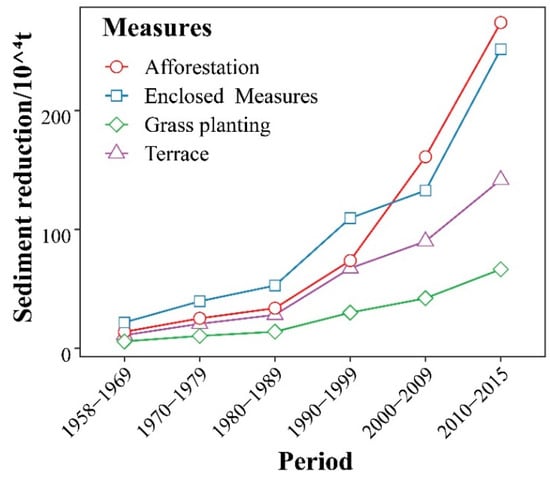
Figure 13.
Sediment reduction by slope measures over various periods in the QRB.
Soil and water conservation measures have exerted a great impact on the reduction in loga. A significant number of previous studies have corroborated this conclusion. Zheng [62] explored the role of check dams on the reduced parameter a in the proportional relationship between discharge and sediment. Sun et al. [60] investigated the inter-annual variations of the relationship between discharge and sediment in the LP and determined a remarkable shift in the regression parameters of the SRCs. More specifically, the authors observed a continuous trend of the declining parameter a following the ecological construction and concluded that soil and water conservation measures play an important role in the decline in parameter a. Gao et al. [63] revealed that vegetation restoration campaigns had the greatest impact on the heterogeneity of the relationship between discharge and sediment.
Soil and water conservation measures exerted no distinctive impacts on the exponent b for the QRB. This may be due to the fact that in loess regions, parameter b is generally a function of the sediment transport capacity. Furthermore, the correlation between sediment size composition and parameter b in this area remains uncertain and therefore needs to be further explored in depth in future research.
The sediment yield and closely associated parameters of the SRCs are likely to fluctuate continuously in the future. This could be attributed to the pervasive land surface alteration and development, the sediment changes induced by human-caused climate system alterations, the necessity to restore the vegetation as one part of ecosystem resilience and restoration projects, and the intrinsic variance of sediment transport, even in the absence of human pressures. Thus, it is of great significance to provide adequate techniques for the quantification of the shift in river system sediments. Recent studies have attempted to use the basin characteristics to predict parameters a and b. Investigating the spatial geographical pattern of SRCs and the physical controls on rating parameters can be of great benefit in the extrapolation of SRCs to ungauged basins. For example, Atieh et al. [64] introduced integrated artificial neural network (ANN) models to predict parameters a and b for ungauged basins. Zhang et al. [65] investigated the spatial heterogeneity in regression parameters of the SRCs and discussed the relationship between regression coefficients and basin physical attributes. In summary, there is a great need to comprehensively understand and precisely quantify the response of the relationship between discharge and sediment to various anthropogenic activities, rendering this an excellent topic for deeper exploration in future.
4.2. Response of Sediment to the Coupling Effect of Vegetation and Precipitation
As a consequence of the development of engineering and vegetation measures, sediment yield in the QRB has declined substantially in recent years. Some engineer measures, however, had lost their efficacy over time as they were gradually clogged with sediment and afterward damaged by floods [63]. Therefore, vegetation could play a larger role in regulating the variations in the relationship between discharge and sediment and reducing soil erosion in the YR.
How to maintain a vegetation ecosystem in a sustainable way and reveal the inter-relationships between precipitation, vegetation, and sediment is presently a critical issue. Too-extensive forest plantations intercept precipitation before it reaches the soil, and the deep roots could extract underground water and reduce soil moisture and may therefore come at the cost of greater water consumption. A scientific assessment of the basin ecosystems based on precipitation–vegetation-erosion interactions is therefore essential to maintain sustainable ecosystems for this fragile loess-soil-dominated land. The inter-relationships involve multiple spatiotemporal scales. The unique combination relationship between precipitation characteristics and vegetation patterns in different areas and this coupling relationship reveals that different regions exhibit different characteristics of erosion processes and sediment production. Therefore, the erosion pattern displays a regional distribution on the macro scale. The groundbreaking work of Langbein and Schumm determined that the specific sediment yield rises with increasing effective rainfall to a peak value and then subsequently falls [66]. The authors attribute this phenomenon to the impact of vegetation on precipitation, and many more studies have subsequently been conducted. Analogous patterns of precipitation-specific sediment yield have since been identified across fields around the globe, and this proven relationship has been dubbed the Langbein and Schumm rule [67].
The impacts of vegetation result in a two-fold impact of precipitation on erosion. Severe erosion may occur in the presence of high precipitation levels. At the same time, when precipitation is plentiful, native vegetation is lush, and subsequently, the resistance to erosion is strong, owing to the high-density vegetation coverage. This might cause the opposing effect, namely, reducing erosion intensity. The anti-erodibility of the earth’s surface can be classified into two categories: the resistance to erosion owing to vegetation and that caused by materials on the ground. Vegetation is a zonal component whose distribution is intimately associated with the distribution of precipitation at the macro-scale. Precipitation influences net primary productivity, vegetation types, and vegetation coverage directly in undisturbed systems. Generally, more precipitation leads to increased vegetation biomass and, as a result, the greater protection of vegetation against erosion, or the stronger resistance to erosion caused by vegetation. As a consequence, there is a negative relationship between soil erosion and precipitation owing to the influence of vegetation.
In summary, the precipitation–erosion relationship is positive if the impacts of precipitation dominate the erosion process in a specific area and the roles of vegetation are secondary, while if the influence of vegetation dominates, then the correlation is negative. Our results revealed non-linear relationships between the NDVI, precipitation, and specific sediment yield based on the monthly data of the QRB and established a coupling effect between vegetation and precipitation.
As shown in Figure 10 and Figure 11, the monthly specific sediments follow a bell-shaped correlation both with the monthly NDVI and monthly precipitation, with the specific sediment yield peaking at monthly NDVI and precipitation values of around 0.36 and 100, respectively. This non-linear relationship is similar to the Langbein–Schumm rule. Areas with more precipitation often have more vegetation cover, whereas areas with a lower NDVI receive less precipitation. When the vegetation index is low, we can generally infer that the transport of sediment is primarily dominated by precipitation. The influence of vegetation initially rises slowly with increasing NDVI and subsequently accelerates after the NDVI surpasses 0.36. The role of the NDVI eventually replaces precipitation as the dominant factor and attenuates the variation in sediment yield. Since well-vegetated regions are more efficient in soil amendment and runoff/sediment reduction, soil erosion in these regions is effectively controlled, and as a result, the comparatively little amount of soil eroded could be readily transported to the rivers.
The non-linear impact of vegetation regarding the sediment resistance to erosion is in accordance with prior research. Xu [28] determined non-linear relationships between vegetation cover, rainfall erosivity, and annual rainfall, and identified some thresholds based on data from the LP of China. Xin et al. [51] demonstrated that the coupling relationship between vegetation coverage and precipitation was similar to the Langbein–Schumm law based on data from 180 gauging stations around the LP, with vegetation coverage becoming a dominant controlling factor for annual precipitation exceeding 460 mm and an NDVI > 0.4. Ye et al. [52] argued that discharge governs the soil erosion and sediment delivery until the NDVI exceeds a threshold of 0.36, at which the driving factor dominating the sediment concentration shifts from precipitation erosion to vegetation retardation, and attributed this to the slow growth of vegetation with increasing resistance to low-level precipitation. Ran et al. [7] analyzed flooding and sediment yield at the event scale, particularly on the complexity induced by the non-linearity of sediment delivery, and observed a bell-shaped trend similar to the relationship reported by Langbein–Schumm.
As the vegetation develops and expands, areas with low vegetation index levels generate a sluggish resistance to soil erosion. According to Rogers and Schumm [68], vegetation can result in the disruption of overland flow, and flow across the surface can be concentrated, deflected, and dispersed by individual vegetation obstructions. Therefore, erosion can develop most vigorously on sparsely vegetated surfaces, with high sediment yields from these surfaces. When vegetation is inundated by floods, its capability to intercept and retain sediment is diminished. Consequently, for basins or stages with restricted vegetation development, vegetation density is inadequate for intercepting sediment, and the vegetation can emerge from the level of rivers during severe rainstorms or hyper-concentrated flow events that deliver the majority of sediment. The delivery of sediment in WT and QYS, sub-basins, with sparse vegetation protection, is usually dominated by precipitation: the greater the amount of the precipitation, the more runoff is incurred and the more soil is eroded and washed into the river. As the NDVI increases, the ability of vegetation to protect against erosion and sediment settlement is enhanced [69]. Despite the fact that precipitation continues to rise, the relationship between precipitation and sediment becomes increasingly decoupled with the compensation from vegetation retardation. The transition point at the NDVI value of 0.36 corresponds to the balance between the increment in sediment reduction caused by vegetation and the incremental rise in soil erosion and sediment production. The net loss of soil becomes negligible when the ability of vegetation retardation can keep pace with the rate of erosion and sediment production. This was observed in well-constructed vegetation regions.
Sediment yield rises with increasing precipitation until reaching a peak value, then decreases when precipitation rises further (Figure 11). When precipitation was very low, the sparse vegetation could not provide enough protection against soil erosion, and meanwhile, the precipitation was not sufficient to generate runoff, resulting in soil erosion and sediment yield. The specific sediment yield rose significantly when the precipitation increased, driven by increased erosion caused by precipitation. The most intense sediment yield appeared when the monthly precipitation was about 100 mm. When precipitation rose further, the sediment yield showed a remarkable decline as the vegetation coverage could provide greater protection. At this stage, vegetation played a more significant role than precipitation. Although the vegetation cover is sufficient to protect the soil and trap the sediment, it cannot completely prevent erosion, which might cause scattering in the precipitation–sediment relationship.
The datasets used in the research of Langbein and Schumm [66] were acquired from humid and well-vegetated drainages. These conditions contrast with the QRB, with an arid and semi-arid climate and relatively poor vegetation coverage. Despite this difference, a similar bell-shaped relationship was also discovered among precipitation, vegetation, and sediment yield in the QRB, the LP [51], and the YR [52]. This suggests that the bell relationship among these variables does not only occur in humid and well-vegetated regions but can also be applicable in arid and poorly-vegetated areas. Langbein and Schumm [66] used data obtained from regions with little human disturbance, as opposed to the YR and the LP, where human activities are intensive. Considering the restricted human activities in these regions, the growth of vegetation is presumably closely related to precipitation, owing to its adaptation to the climate. This indicates that the bell-shaped relationship between precipitation, vegetation, and sediment yield is not only present in the YR with intense and severe anthropogenic activities, but can also be confirmed in areas with limited anthropogenic activities. Further work is required to validate the universality of this bell-shaped relationship in other drainages.
4.3. Potential Influence of NDVI Lags on Sediment Yield in the QRB
Sediment yield in the QRB is influenced by the combination of precipitation and vegetation. There is a universal consensus that high-density vegetation coverage is essential for mitigating soil erosion in the YR, particularly during high-intensity precipitation events [16]. The local climate exerts a significant impact on both the growth of vegetation and soil erosion in the YR. During the last three decades, vegetation growth trends have improved considerably in numerous areas of the YR [39]. Vegetation growth, however, is a comparatively slow procedure, and even under optimal climate conditions, the vegetation cannot develop overnight. In contrast to the immediate response of soil to precipitation, vegetation growth responds to precipitation over a considerably longer time. Thus, the time lags between vegetation growth and climatic variable responses can be anticipated. Ning et al. [70] attributed lags following precipitation to the considerable amount of rainfall during the rainy season, which cannot be entirely consumed by plants. Previous research has demonstrated that local soil can maintain the water, allowing plants to continue to thrive for a prolonged time subsequent to the rainfall [54].
Table 3 lists a lag in the order of NDVI phenology and precipitation. This indicates that vegetation development is influenced not only by current climatic conditions but also by preceding climate patterns. We estimated the lag time of vegetation’s response to precipitation in the QRB to be approximately 0–2 months, based on the results of the time lag between precipitation and the NDVI. This is compatible with the previous studies that suggest that the time lag of vegetation responses to climatic variables should not exceed three months [53]. For example, Huang et al. [30] observed that the four MODIS-derived vegetation indices were associated with the climatic factor time series of the preceding months or of the current month. However, the majority of the early studies evaluated the impacts of the time lags at the monthly scale due to the limitations of coarse resolution and methodological constraints. Therefore, it is of value to determine reliable time lags at the daily scale by reconstructing the corresponding monthly climate sequences. Moreover, the majority of previous studies generally concentrate on the presence and spatial distribution of these time lags, while the effects of time lags on the sediment yield are usually ignored. As already stated, the sediment yield of the QRB can be determined by the combination of precipitation and vegetation. In theory, favorable climate conditions may encourage the development of vegetation, which is beneficial to sediment retardation. A heavy rainstorm, on the other hand, is capable of fiercely eroding the soil and may not supply enough water to maintain the growth of vegetation [67]. Figure 14 depicts the intra-annual variations in precipitation (P), NDVI, and sediment yield (SY) for six sub-basins in the QRB. As seen in Figure 14, almost all the precipitation, NDVIs, and sediment yields exhibit single-peak curves across the whole year. Furthermore, the majority of sediment production events occur during the flood season, and sediment yield fluctuates with precipitation and NDVI. Once the NDVI reaches its maximum value, the sediment yield falls sharply, which may be attributed to the increasing interception of precipitation, demonstrating the critical function of vegetation coverage in suppressing soil erosion in the QRB (Figure 15). Kong et al. [71] extracted the values of the NDVI and sediment yield at a similar level of precipitation to eliminate the interference from check dams and determined a reduction in sediment loss when the NDVI increased, even at equivalent erosion intensity.
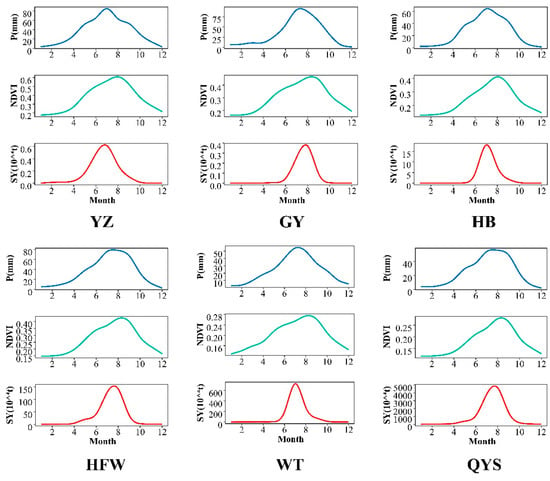
Figure 14.
Mean monthly precipitation (P), NDVI, and sediment yield (SY) in 2006–2016 for six sub-basins across the QRB.
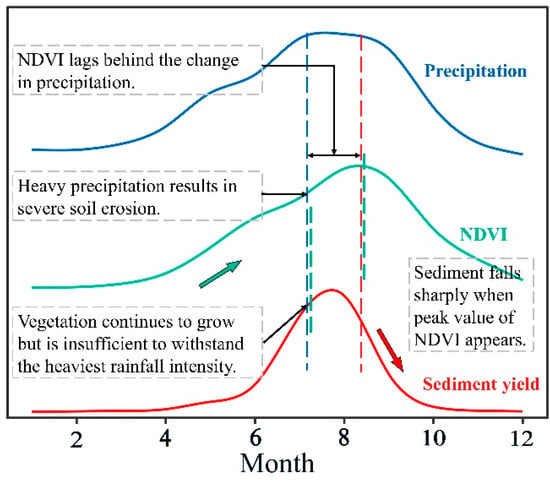
Figure 15.
Illustration of the potential influence of NDVI time lags on sediment in the QRB.
However, the NDVI values remained comparatively small when the sediment yield approached its peak value due to the effects of time lags. As a result, it could be further deduced that shortening or even reversing the time lags may be effective in mitigating soil erosion. This may be accomplished theoretically by incorporating new vegetation types into the QRB without eliminating the present plants. Perennial plants, as opposed to annual plants, are likely to be favored. Furthermore, plants that are less sensitive to climate change may effectively reduce the time lag between variations between seasonal climatic variables and variations in vegetation. Our research might provide a valuable theoretical foundation for decision-making on vegetation construction in the QRB.
5. Conclusions
In this study, we explored the coupling effects of precipitation and vegetation on sediment yield from the perspective of spatiotemporal heterogeneity across the Qingshui River Basin of the upper Yellow River, China. First, we analyzed the spatial and temporal variations of the river runoff and sediment discharge in the QRB at different sub-basins. Then, we discussed the changes in sediment transport mechanisms caused by the large-scale ecological restoration by examining the changes in the parameters of SRCs. In general, the river runoff and sediment discharge in the QRB exhibited a downward trend in recent years. A continuously decreasing trend was observed in parameter a of the SRCs, which could be attributed to the combined effects of engineering and vegetation measures. Among all the soil and water conservation measures, vegetation has proven to be the most effective factor in reducing sediment. Sediment yield in the QRB is influenced by the coupling between precipitation and vegetation. Due to the sluggish progression of vegetation resistance with rising precipitation at low precipitation levels, precipitation dominated the processes of soil erosion and sediment delivery until the NDVI exceeded 0.36, whereby the parameter governing sediment yield shifted from precipitation to vegetation retardation. We determined the lag time of vegetation’s response to precipitation to be approximately 0–2 months in the QRB. Our results suggest that improving vegetation coverage or shortening the time lags between precipitation and vegetative response can be beneficial to the control of soil erosion. The findings provide valuable information to guide ecological rehabilitation studies. Moreover, it is important to collect more data to further validate our results concerning the precipitation–vegetation–erosion coupling at more gauges in the YR. The investigation of additional basins with various climate and vegetation conditions at the global scale is also reserved for future work.
Author Contributions
Hydrometeorological data collection: H.Z. and J.Y.; data analysis: J.Y. and W.Y.; manuscript drafting: J.Y.; research design: H.Z. and J.Y.; manuscript revision: H.Z. All authors have read and agreed to the published version of the manuscript.
Funding
This research was funded by the Fundamental Research Funds for the Central Universities (NO.2021ZY50), the Joint Open Research Fund Program of the State Key Laboratory of Hydroscience and Engineering, and the Tsinghua–Ningxia Yinchuan Joint Institute of Internet of Waters on Digital Water Governance (sklhse-2022-Iow10) and the National Natural Science Foundation of China (NO. 51309006). We gratefully acknowledge the Beijing Municipal Education Commission for their financial support through the Innovative Transdisciplinary Program “Ecological Restoration Engineering”.
Institutional Review Board Statement
Not applicable.
Informed Consent Statement
Not applicable.
Data Availability Statement
Sources of the geospatial and vegetation coverage data used in this study have been describe in Section 2.2, “Data Collection and Processing”. The runoff and sediment data are shown in the figures of the paper and are available through contacting the authors.
Acknowledgments
We gratefully acknowledge the state key laboratory of hydroscience and engineering, Tsinghua University, for their financial support for the main part of the research. The authors sincerely thank Xingkui Wang and Baosheng Wu, Tsinghua University, for their constructive advice and immense help to improve this study. We also sincerely thank the anonymous reviewers and editor for their constructive comments and suggestions.
Conflicts of Interest
The authors declare no conflict of interest.
References
- Walling, D.E.; Fang, D. Recent trends in the suspended sediment loads of the world’s rivers. Glob. Planet Chang. 2003, 39, 111–126. [Google Scholar] [CrossRef]
- Syvitski, J.P.M. Supply and flux of sediment along hydrological pathways: Research for the 21st century. Glob. Planet Chang. 2003, 39, 1–11. [Google Scholar] [CrossRef]
- Wang, S.; Fu, B.; Piao, S.; Lü, Y.; Ciais, P.; Feng, X.; Wang, Y. Reduced sediment transport in the Yellow River due to anthropogenic changes. Nat. Geosci. 2016, 9, 38–41. [Google Scholar] [CrossRef]
- Darby, S.E.; Hackney, C.R.; Leyland, J.; Kummu, M.; Lauri, H.; Parsons, D.R.; Best, J.L.; Nicholas, A.P.; Aalto, R. Fluvial sediment supply to a mega-delta reduced by shifting tropical-cyclone activity. Nature 2016, 539, 276–279. [Google Scholar] [CrossRef] [Green Version]
- Li, L.; Ni, J.; Chang, F.; Yue, Y.; Frolova, N.; Magritsky, D.; Borthwick, A.; Ciais, P.; Wang, Y.; Zheng, C.; et al. Global trends in water and sediment fluxes of the world’s large rivers. Sci. Bull. 2020, 65, 62–69. [Google Scholar] [CrossRef] [Green Version]
- Best, J. Anthropogenic stresses on the world’s big rivers. Nat. Geosci. 2019, 12, 148. [Google Scholar] [CrossRef]
- Ran, Q.; Zong, X.; Ye, S.; Gao, J.; Hong, Y. Dominant mechanism for annual maximum flood and sediment events generation in the Yellow River basin. Catena 2020, 187, 104376. [Google Scholar] [CrossRef]
- Yu, L. The Huanghe (Yellow) River: Recent changes and its countermeasures. Cont. Shelf Res. 2006, 26, 2281–2298. [Google Scholar] [CrossRef]
- Shen, H.; Zheng, F.; Wen, L.; Han, Y.; Hu, W. Impacts of rainfall intensity and slope gradient on rill erosion processes at loessial hillslope. Soil Till. Res. 2016, 155, 429–436. [Google Scholar] [CrossRef]
- Sun, W.; Mu, X.; Song, X.; Wu, D.; Cheng, A.; Qiu, B. Changes in extreme temperature and precipitation events in the Loess Plateau (China) during 1960–2013 under global warming. Atmos. Res. 2016, 168, 33–48. [Google Scholar] [CrossRef]
- Zhao, G.; Mu, X.; Wen, Z.; Wang, F.; Gao, P. Soil erosion, conservation, and eco-environment changes in the Loess Plateau of China. Land Degrad. Dev. 2013, 24, 499–510. [Google Scholar] [CrossRef]
- Chen, L.; Messing, I.; Zhang, S.; Fu, B.; Ledin, S. Land use evaluation and scenario analysis towards sustainable planning on the Loess Plateau in China-case study in a small catchment. Catena 2003, 54, 303–316. [Google Scholar] [CrossRef]
- Han, X.; Xiao, J.; Wang, L.; Tian, S.; Liang, T.; Liu, Y. Identification of areas vulnerable to soil erosion and risk assessment of phosphorus transport in a typical watershed in the Loess Plateau. Sci. Total Environ. 2021, 758, 143661. [Google Scholar] [CrossRef] [PubMed]
- Hessel, R.; Messing, I.; Liding, C.; Ritsema, C.; Stolte, J. Soil erosion simulations of land use scenarios for a small Loess Plateau catchment. Catena 2003, 54, 289–302. [Google Scholar] [CrossRef]
- Zhang, X.; Song, J.; Wang, Y.; Deng, W.; Liu, Y. Effects of land use on slope runoff and soil loss in the Loess Plateau of China: A meta-analysis. Sci. Total Environ. 2021, 755, 142418. [Google Scholar] [CrossRef]
- Fu, B.; Wang, S.; Liu, Y.; Liu, J.; Liang, W.; Miao, C. Hydrogeomorphic ecosystem responses to natural and anthropogenic changes in the Loess Plateau of China. Annu. Rev. Earth Planet Sci. 2017, 45, 223–243. [Google Scholar] [CrossRef]
- Liang, W.; Bai, D.; Wang, F.; Fu, B.; Yan, J.; Wang, S.; Yang, Y.; Long, D.; Feng, M. Quantifying the impacts of climate change and ecological restoration on streamflow changes based on a Budyko hydrological model in China’s Loess Plateau. Water Resour. Res. 2015, 51, 6500–6519. [Google Scholar] [CrossRef]
- Wang, S.; Fu, B.; Liang, W. Developing policy for the Yellow River sediment sustainable control. Natl. Sci. Rev. 2016, 3, 162–164. [Google Scholar] [CrossRef] [Green Version]
- Wang, S.; Fu, B.; Liang, W.; Liu, Y.; Wang, Y. Driving forces of changes in the water and sediment relationship in the Yellow River. Sci. Total Environ. 2017, 576, 453–461. [Google Scholar] [CrossRef]
- Chen, L.; Wei, W.; Fu, B.; Lü, Y. Soil and water conservation on the Loess Plateau in China: Review and perspective. Prog. Phys. Geog. 2007, 31, 389–403. [Google Scholar] [CrossRef]
- Shi, C.; Zhou, Y.; Fan, X.; Shao, W. A study on the annual runoff change and its relationship with water and soil conservation practices and climate change in the middle Yellow River basin. Catena 2013, 100, 31–41. [Google Scholar] [CrossRef]
- Yang, X.; Sun, W.; Li, P.; Mu, X.; Gao, P.; Zhao, G. Reduced sediment transport in the Chinese Loess Plateau due to climate change and human activities. Sci. Total Environ. 2018, 642, 591–600. [Google Scholar] [CrossRef] [PubMed]
- Chen, H.; Cai, Q. Impact of hillslope vegetation restoration on gully erosion induced sediment yield. Sci. China Ser. D 2006, 49, 176–192. [Google Scholar] [CrossRef]
- Chen, H.; Zhou, J.; Cai, Q.; Yue, Z.; Lu, Z.; Liang, G.; Huang, J. The impact of vegetation restoration on erosion-induced sediment yield in the middle Yellow River and management prospect. Sci. China Ser. D 2005, 48, 724–741. [Google Scholar] [CrossRef]
- Liu, X.; Yang, S.; Dang, S.; Luo, Y.; Li, X.; Zhou, X. Response of sediment yield to vegetation restoration at a large spatial scale in the Loess Plateau. Sci. China Technol. Sci. 2014, 57, 1482–1489. [Google Scholar] [CrossRef]
- Murray, S.J.; Foster, P.N.; Prentice, I.C. Future global water resources with respect to climate change and water withdrawals as estimated by a dynamic global vegetation model. J. Hydrol. 2012, 448, 14–29. [Google Scholar] [CrossRef]
- Hu, J.; Gao, P.; Mu, X.; Zhao, G.; Sun, W.; Li, P.; Zhang, L. Runoff-sediment dynamics under different flood patterns in a Loess Plateau catchment, China. Catena 2019, 173, 234–245. [Google Scholar] [CrossRef]
- Xu, J. Precipitation-vegetation coupling and its influence on erosion on the Loess Plateau, China. Catena 2005, 64, 103–116. [Google Scholar]
- Houborg, R.; Boegh, E. Mapping leaf chlorophyll and leaf area index using inverse and forward canopy reflectance modeling and SPOT reflectance data. Remote Sens. Environ. 2008, 112, 186–202. [Google Scholar] [CrossRef]
- Huang, X.; Fang, N.; Shi, Z.; Zhu, T.; Wang, L. Decoupling the effects of vegetation dynamics and climate variability on watershed hydrological characteristics on a monthly scale from subtropical China. Agric. Ecosyst. Environ. 2019, 279, 14–24. [Google Scholar] [CrossRef]
- Rammig, A.; Wiedermann, M.; Donges, J.F.; Babst, F.; von Bloh, W.; Frank, D.; Thonicke, K.; Mahecha, M.D. Coincidences of climate extremes and anomalous vegetation responses: Comparing tree ring patterns to simulated productivity. Biogeosciences 2015, 12, 373–385. [Google Scholar] [CrossRef] [Green Version]
- Zhao, A.; Zhang, A.; Liu, X.; Cao, S. Spatiotemporal changes of normalized difference vegetation index (NDVI) and response to climate extremes and ecological restoration in the Loess Plateau, China. Theor. Appl. Climatol. 2018, 132, 555–567. [Google Scholar] [CrossRef]
- Reyer, C.P.; Silveyra Gonzalez, R.; Dolos, K.; Hartig, F.; Hauf, Y.; Noack, M.; Lasch-Born, P.; Rötzer, T.; Pretzsch, H.; Meesenburg, H.; et al. The PROFOUND Database for evaluating vegetation models and simulating climate impacts on European forests. Earth Syst. Sci. Data 2020, 12, 1295–1320. [Google Scholar] [CrossRef]
- Ding, Y.; Li, Z.; Peng, S. Global analysis of time-lag and -accumulation effects of climate on vegetation growth. Int. J. Appl. Earth Obs. 2020, 92, 102179. [Google Scholar] [CrossRef]
- Tian, S.; Xu, M.; Jiang, E.; Wang, G.; Hu, H.; Liu, X. Temporal variations of runoff and sediment load in the upper Yellow River, China. J. Hydrol. 2019, 568, 46–56. [Google Scholar] [CrossRef]
- Jiao, P.; Wei, W.; Bao, H. Variation and Trend Analysis of Rainfall in Qingshui River Basin of Ningxia in China, IOP Conference Series: Earth and Environmental Science. IOP Publ. 2020, 526, 012040. [Google Scholar]
- Zhao, Y.; Cao, W.; Hu, C. Analysis of changes in characteristics of flood and sediment yield in typical basins of the Yellow River under extreme rainfall events. Catena 2019, 177, 31–40. [Google Scholar] [CrossRef]
- Li, C.; Zhang, H.; Singh, V.P.; Fan, J.; Wei, X.; Yang, J.; Wei, X. Investigating variations of precipitation concentration in the transitional zone between Qinling Mountains and Loess Plateau in China: Implications for regional impacts of AO and WPSH. PLoS ONE 2020, 15, e0238709. [Google Scholar] [CrossRef]
- Shi, S.; Yu, J.; Wang, F.; Wang, P.; Zhang, Y.; Jin, K. Quantitative contributions of climate change and human activities to vegetation changes over multiple time scales on the Loess Plateau. Sci. Total Environ. 2021, 755, 142419. [Google Scholar] [CrossRef]
- Ahn, K.H.; Steinschneider, S. Time-varying suspended sediment-discharge rating curves to estimate climate impacts on fluvial sediment transport. Hydrol. Process. 2018, 32, 102–117. [Google Scholar] [CrossRef]
- De Girolamo, A.M.; Pappagallo, G.; Lo Porto, A. Temporal variability of suspended sediment transport and rating curves in a Mediterranean river basin: The Celone (SE Italy). Catena 2015, 128, 135–143. [Google Scholar] [CrossRef]
- Khaleghi, M.R.; Varvani, J. Sediment Rating Curve Parameters Relationship with Watershed Characteristics in the Semiarid River Watersheds. Arab. J. Sci. Eng. 2018, 43, 3725–3737. [Google Scholar] [CrossRef]
- Zhang, W.; Wei, X.; Zheng, J.; Zhu, Y.; Zhang, Y. Estimating suspended sediment loads in the Pearl River Delta region using sediment rating curves. Cont. Shelf Res. 2012, 38, 35–46. [Google Scholar] [CrossRef]
- Hu, B.; Wang, H.; Yang, Z.; Sun, X. Temporal and spatial variations of sediment rating curves in the Changjiang (Yangtze River) basin and their implications. Quatern. Int. 2011, 230, 34–43. [Google Scholar] [CrossRef]
- Warrick, J.A. Trend analyses with river sediment rating curves. Hydrol. Process. 2015, 29, 936–949. [Google Scholar] [CrossRef]
- Kendall, M. Rank Correlation Methods; Charles Griffin: London, UK, 1975. [Google Scholar]
- Mann, H.B. Nonparametric tests against trend. Econom. J. Econom. Soc. 1945, 245–259. [Google Scholar] [CrossRef]
- Sen, P.K. Estimates of the regression coefficient based on Kendall’s tau. J. Am. Stat. Assoc. 1968, 63, 1379–1389. [Google Scholar] [CrossRef]
- Chu, H.; Venevsky, S.; Wu, C.; Wang, M. NDVI-based vegetation dynamics and its response to climate changes at Amur-Heilongjiang River Basin from 1982 to 2015. Sci. Total Environ. 2019, 650, 2051–2062. [Google Scholar] [CrossRef]
- Li, J.; Peng, S.; Li, Z. Detecting and attributing vegetation changes on China’s Loess Plateau. Agric. Forest Meteorol. 2017, 247, 260–270. [Google Scholar] [CrossRef]
- Xin, Z.; Yu, X.; Lu, X. Factors controlling sediment yield in China’s Loess Plateau. Earth Surf. Proc. Land. 2011, 36, 816–826. [Google Scholar] [CrossRef]
- Ye, S.; Ran, Q.; Fu, X.; Hu, C.; Wang, G.; Parker, G.; Chen, X.; Zhang, S. Emergent stationarity in Yellow River sediment transport and the underlying shift of dominance: From streamflow to vegetation. Hydrol. Earth Syst. Sci. 2019, 23, 549–556. [Google Scholar] [CrossRef] [Green Version]
- Rundquist, B.C.; Harrington, J.A., Jr. The effects of climatic factors on vegetation dynamics of tallgrass and shortgrass cover. Geocarto. Int. 2000, 15, 33–38. [Google Scholar] [CrossRef]
- Zhao, J.; Huang, S.; Huang, Q.; Wang, H.; Leng, G.; Fang, W. Time-lagged response of vegetation dynamics to climatic and teleconnection factors. Catena 2020, 189, 104474. [Google Scholar] [CrossRef]
- Wang, H.; Sun, F. Variability of annual sediment load and runoff in the Yellow River for the last 100 years (1919–2018). Sci. Total Environ. 2021, 758, 143715. [Google Scholar] [CrossRef]
- Zheng, K.; Wei, J.; Pei, J.; Cheng, H.; Zhang, X.; Huang, F.; Li, F.; Ye, J. Impacts of climate change and human activities on grassland vegetation variation in the Chinese Loess Plateau. Sci. Total Environ. 2019, 660, 236–244. [Google Scholar] [CrossRef] [PubMed]
- Duan, J.; Liu, Y.; Tang, C.; Shi, Z.; Yang, J. Efficacy of orchard terrace measures to minimize water erosion caused by extreme rainfall in the hilly region of China: Long-term continuous in situ observations. J. Environ. Manag. 2021, 278, 11537. [Google Scholar] [CrossRef] [PubMed]
- Mukai, S.; Billi, P.; Haregeweyn, N.; Hordofa, T. Long-term effectiveness of indigenous and introduced soil and water conservation measures in soil loss and slope gradient reductions in the semi-arid Ethiopian lowlands. Geoderma 2021, 382, 114757. [Google Scholar] [CrossRef]
- Wang, T.; Hou, J.; Li, P.; Zhao, J.; Li, Z.; Matta, E.; Ma, L.; Hinkelmann, R. Quantitative assessment of check dam system impacts on catchment flood characteristics-a case in hilly and gully area of the Loess Plateau, China. Nat. Hazards 2021, 105, 3059–3077. [Google Scholar] [CrossRef]
- Sun, P.; Wu, Y.; Yang, Z.; Sivakumar, B.; Qiu, L.; Liu, S.; Cai, Y. Can the Grain-for-Green Program really ensure a low sediment load on the Chinese Loess Plateau? Engineering 2019, 5, 855–864. [Google Scholar] [CrossRef]
- Li, Y.; Jiao, P.; Zhang, X.; Yang, J.; Wei, W. Change of precipitation and sediment of Qingshui River Basin of Ningxia in recent 60 years. Res. Soil Water Conserv. 2021, 28, 184–189. [Google Scholar]
- Zheng, M. A spatially invariant sediment rating curve and its temporal change following watershed management in the Chinese Loess Plateau. Sci. Total Environ. 2018, 630, 1453–1463. [Google Scholar] [CrossRef]
- Gao, G.; Fu, B.; Zhang, J.; Ma, Y.; Sivapalan, M. Multiscale temporal variability of flow-sediment relationships during the 1950s-2014 in the Loess Plateau, China. J. Hydrol. 2018, 563, 609–619. [Google Scholar] [CrossRef]
- Atieh, M.; Mehltretter, S.L.; Gharabaghi, B.; Rudra, R. Integrative neural networks model for prediction of sediment rating curve parameters for ungauged basins. J. Hydrol. 2015, 531, 1095–1107. [Google Scholar] [CrossRef]
- Zhang, S.; Chen, D.; Li, F.; He, L.; Yan, M.; Yan, Y. Evaluating spatial variation of suspended sediment rating curves in the middle Yellow River basin, China. Hydrol. Process. 2018, 32, 1616–1624. [Google Scholar] [CrossRef]
- Langbein, W.B.; Schumm, S.A. Yield of sediment in relation to mean annual precipitation. Eos Trans. Am. Geophys. Union 1958, 39, 1076–1084. [Google Scholar] [CrossRef] [Green Version]
- Douglas, I. Man, vegetation and the sediment yields of rivers. Nature 1967, 215, 925–928. [Google Scholar] [CrossRef]
- Rogers, R.; Schumm, S.A. The effect of sparse vegetative cover on erosion and sediment yield. J. Hydrol. 1991, 123, 19–24. [Google Scholar] [CrossRef]
- Corenblit, D.; Steiger, J.; Gurnell, A.M.; Tabacchi, E.; Roques, L. Control of sediment dynamics by vegetation as a key function driving biogeomorphic succession within fluvial corridors. Earth Surf. Proc. Land. 2009, 34, 1790–1810. [Google Scholar] [CrossRef]
- Ning, T.; Liu, W.; Lin, W.; Song, X. NDVI Variation and its responses to Climate Change on the Northern Loess Plateau of China from 1998 to 2012. Adv. Meteorol. 2015, 2015, 1–10. [Google Scholar] [CrossRef] [Green Version]
- Kong, D.; Miao, C.; Wu, J.; Zheng, H.; Wu, S. Time lag of vegetation growth on the Loess Plateau in response to climate factors: Estimation, distribution, and influence. Sci. Total. Environ. 2020, 744, 140726. [Google Scholar] [CrossRef] [PubMed]
Publisher’s Note: MDPI stays neutral with regard to jurisdictional claims in published maps and institutional affiliations. |
© 2022 by the authors. Licensee MDPI, Basel, Switzerland. This article is an open access article distributed under the terms and conditions of the Creative Commons Attribution (CC BY) license (https://creativecommons.org/licenses/by/4.0/).